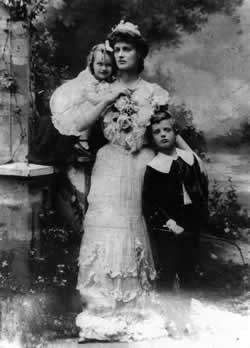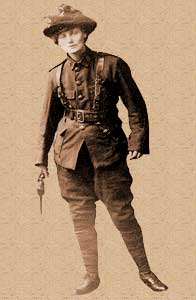 Constance Gore-Booth (1868-1927) daughter of the famous Arctic explorer Sir Henry Gore-Booth, made a name for herself by jigging her way out of her father’s shadow and becoming the Matriarch of Irish female insurrectionists.
Constance Gore-Booth (1868-1927) daughter of the famous Arctic explorer Sir Henry Gore-Booth, made a name for herself by jigging her way out of her father’s shadow and becoming the Matriarch of Irish female insurrectionists.
Constance was born in London to a famous father who owned a large estate in County Sligo Ireland. Sir Henry was an odd-duck for his time as he was compassionate to the plight of the Irish during the worst of the Potato Famine. Sir Henry’s ideology deeply affected Constance and her sister Eva. Eva later became a leader in the labor and suffrage movements in England, while Constance eventually took up the cause of Irish freedom.
What led Constance to forward her regard for the Irish poor to the need for Irish freedom might have something to do with the company she kept. Constance fancied herself an artist and had many artistic friends, most notably, William Butler Yeats, who later wrote a poem dedicated to the Gore-Booth sisters.
What many may not realize is the nationalistic ideas and movements were long fostered in the Irish arts community. The arts were a means of keeping the culture alive and be it poetry, song, or plays, it was one of the few venues the Irish had to voice their outrage over the conditions in which they were subjected to.
 Constance joined this community with dreams of becoming a painter. She studied in Dublin for a time before moving on to France. All the while becoming involved in political movements regarding labor, suffrage, and equal rights. I was during her time in France in 1901 that Constance met and married Count Kazimierz Dunin-Markiewicz, a Polish Aristocrat who conveniently was also a painter and playwright. This was obviously a shot-gun marriage as Constance gave birth to a daughter shortly thereafter.
Constance joined this community with dreams of becoming a painter. She studied in Dublin for a time before moving on to France. All the while becoming involved in political movements regarding labor, suffrage, and equal rights. I was during her time in France in 1901 that Constance met and married Count Kazimierz Dunin-Markiewicz, a Polish Aristocrat who conveniently was also a painter and playwright. This was obviously a shot-gun marriage as Constance gave birth to a daughter shortly thereafter.
The Markieviczs moved to Dublin in 1903 becoming one of the mainstays in artistic circles. Through these circles, Constance became involved with the Gaelic League, an organization devoted to preserving Irish culture and language and served as incubator to the future leaders of Ireland, such as Douglas Hyde, future first president of a free Ireland.
By 1908, Constance had all but left a life of art behind and led a life devoted to Irish politics and attaining Irish freedom. And proving that you can take the girl out of the royal carriage but you can not take the royalty out of the girl, Constance turned up for her meeting of women’s revolutionary movement in a ballgown and tiara. True story.
The fun stuff really begins when Constance set her tiara towards taking down Winston Churchill in a parliamentary election. She showed up to Parliament in a carriage drawn by four white horses just to make a spectacle of it. She lost of course, but the effect was powerful. The suffragists were able to split the Churchill vote and thus give the election to another opposition candidate.

Mugshot of Countess Markievicz
The deeper Constance embroiled herself into the cause, the more radical she became. In 1909, she founded Fianna Eireann, a paramilitary training corps for Irish teenage boys. Constance also was arrested for speaking in favor of the Irish Republican Brotherhood, and for protesting the visit of King George V in 1911. When workers suffered a lock-out for protesting against police brutality, Constance paid for food to feed families out of her own pocket and started local soup kitchens. In fact, Constance eventually sacrificed nearly all of her own wealth in support of the cause.
The long strain of Republicanism on Constance’s marriage took its toll by 1913 when her husband moved to the Ukraine never to return to Ireland. By 1916, Constance was fully immersed in planning and execution of the Easter Rising. Constance put down her tiara, picked a gun and served as second in command at the St. Stephen’s barricade, one of many encampments through the six-day long siege of the city.
Constance dug trenches, set up barricades, actually shot a British solider, and refused surrender until she received a copy of surrender orders from the the top command.
Of the 70 women arrested during the uprising and serving as “guests” at the Kilmainham Gaol, Constance was the only to be placed in solitary confinement. She further sassed her captors at her court-martial and when her sentence of death was commuted on account of her gender, she replied to the court: “I wish your lot had the decency to shoot me.”
Politics being what they are and the swell of support that arose from Irish Catholics to the government response of the Eater Rising, Constance was released in 1917. Shortly after, Constance renounce her Anglican faith and converted to Catholicism.
In 1918, Constance was jailed again for anti-conscription shananigans. While in jail, however, Constance was voted into the British House of Commons under the Sinn Fein party. The first women ever elected. As a part of general protest, she refused to take her seat.The first Dail Eireann convened in 1918 declaring Ireland a free republic and generally kicking off the Irish War for Independence.

Constance served in government, most notably as labor secretary, until 1922 when Eamon de Valera, Constance and other followers resigned in protest over the passage of the Anglo-Irish Treaty which formally separated North and South Ireland.
A major turn-about occurs in 1923, when Constance, re-elected to government yet again, refused to take her seat and participated in other activities considered detrimental to the new Irish state. She was jailed, again, and led 92 other women in a hunger strike.
Constance kept her foot in the door of Irish politics until her death in 1927 at the age of 59. Years of working in Dublin poorhouses more than likely exposed her to tuberculosis listed as the official cause of death. Her estranged husband returned from abroad and was at her side when she died.
Eamon de Valera provided her eulogy. Sean O’Casey, the famous Irish playwright, provides the most memorable quote about Constance:
“One thing she had in abundance—-physical courage; with that she was clothed as with a garment”.
 Because we’ve now got two seasons of
Because we’ve now got two seasons of 


